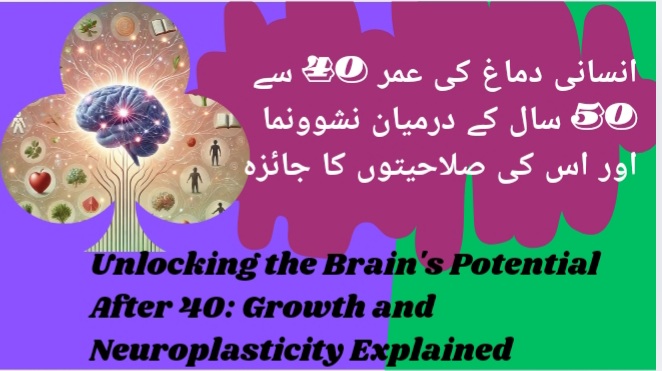انسانی دماغ کی عمر 40 سے 50 سال کے درمیان نشوونما اور اس کی صلاحیتوں کا جائزہ
انسانی دماغ قدرت کا ایک حیرت انگیز تحفہ ہے، جو زندگی کے ہر مرحلے میں منفرد انداز میں کام کرتا ہے۔ عام طور پر انسانی دماغ کی جسمانی اور ساختی نشوونما 25 سال کی عمر تک مکمل ہو جاتی ہے، لیکن اس کے بعد بھی دماغی صلاحیتوں کی نشوونما، نیورل کنکشنز بنانے، اور سیکھنے کا عمل جاری رہتا ہے۔ خاص طور پر 40 سے 50 سال کی عمر کے دوران، دماغ کئی لحاظ سے ترقی پذیر رہتا ہے۔
دماغ کی نشوونما اور نیوروپلاسٹیسٹی (Neuroplasticity)
نیوروپلاسٹیسٹی انسانی دماغ کی وہ حیرت انگیز صلاحیت ہے، جو اسے نئی معلومات کو اپنانے، تبدیلیوں سے ہم آہنگ ہونے، اور نئی مہارتیں سیکھنے کے قابل بناتی ہے۔
- زندگی بھر سیکھنے کی صلاحیت: تحقیق سے یہ ثابت ہوا ہے کہ دماغ کسی بھی عمر میں نئی چیزیں سیکھنے کی صلاحیت رکھتا ہے، خاص طور پر اگر دماغ کو متحرک رکھا جائے۔
- نیورل کنکشنز: 40 سے 50 سال کی عمر میں دماغ مسلسل نئے نیورل کنکشنز بناتا رہتا ہے، جو سیکھنے اور تجربات کے ذریعے مضبوط ہوتے ہیں۔
حوالہ:
ماہرینِ نفسیات اور نیوروسائنس کی تحقیق سے ثابت ہے کہ نیوروپلاسٹیسٹی 50 سال یا اس سے زائد عمر تک برقرار رہ سکتی ہے (Source: Frontiers in Psychology, 2023)۔
علمی صلاحیتوں میں اضافہ
40 سے 50 سال کی عمر میں انسان کے دماغ کی تجربہ اور حکمت پر مبنی صلاحیتوں میں بہتری آ سکتی ہے۔
- مسائل حل کرنے کی مہارت: عمر کے ساتھ تجربات کی بنیاد پر مسائل کا تجزیہ کرنے اور بہتر حل نکالنے کی صلاحیت بہتر ہوتی ہے۔
- یادداشت: اگرچہ بعض اوقات یادداشت کی رفتار میں کمی آ سکتی ہے، لیکن عملی یادداشت (working memory) مضبوط ہو سکتی ہے۔
- جذباتی ذہانت: اس عمر میں لوگ جذبات کو بہتر طریقے سے سمجھنے اور قابو پانے کی صلاحیت حاصل کر سکتے ہیں۔
حوالہ:
امریکن جرنل آف سائیکالوجی کے مطابق، دماغ 40 کے بعد زیادہ سمجھدار، اور تجربات سے سیکھنے کی طاقتور صلاحیت رکھتا ہے (Source: American Journal of Psychology, 2022)۔
دماغ کی صحت پر اثرات
40 سے 50 سال کی عمر میں دماغ کی صحت کو بہتر رکھنے کے لیے مخصوص عوامل اہم کردار ادا کرتے ہیں:
- متوازن غذا: صحت بخش خوراک، مثلاً اومیگا 3 فیٹی ایسڈز اور اینٹی آکسیڈنٹس، دماغی خلیات کی حفاظت کرتے ہیں۔
- جسمانی سرگرمیاں: ورزش نہ صرف جسم بلکہ دماغ کو بھی متحرک اور صحت مند رکھتی ہے۔
- ذہنی مشقیں: دماغی کھیل، مطالعہ، اور سیکھنے کی عادات دماغی صحت کو بہتر بناتی ہیں۔
حوالہ:
“نیچر نیوروسائنس” میں شائع ہونے والی تحقیق کے مطابق، جسمانی ورزش اور متوازن غذا عمر رسیدہ افراد کے دماغی افعال کو مضبوط بنانے میں معاون ہوتی ہے (Source: Nature Neuroscience, 2021)۔
دماغی نشوونما میں رکاوٹیں
عمر کے ساتھ بعض رکاوٹیں بھی سامنے آ سکتی ہیں، جن سے بچاؤ ممکن ہے:
- دماغی بیماریوں کا خطرہ: الزائمر اور دیگر نیورولوجیکل بیماریوں کا امکان بڑھ سکتا ہے۔
- نیورونز کی کمی: نیورونز کی تعداد میں کمی ممکن ہے، لیکن نیورل کنکشنز کو برقرار رکھ کر اس نقصان کو کم کیا جا سکتا ہے۔
- ذہنی دباؤ: تناؤ اور ڈپریشن دماغی نشوونما پر منفی اثر ڈال سکتے ہیں۔
حوالہ:
ورلڈ ہیلتھ آرگنائزیشن (WHO) کے مطابق، تناؤ کم کرنے اور مثبت ذہنی رویہ اپنانے سے دماغی صحت کو بہتر رکھا جا سکتا ہے (Source: WHO Mental Health Report, 2020)۔
عملی اقدامات: دماغ کو متحرک رکھنے کے طریقے
دماغی نشوونما کے لیے درج ذیل اقدامات مفید ہو سکتے ہیں:
- نئی زبان سیکھیں: یہ نیورل کنکشنز بنانے کے لیے بہترین عمل ہے۔
- مطالعہ اور ذہنی کھیل: شطرنج، کراس ورڈ پزلز، اور کتابیں پڑھنا دماغ کو متحرک رکھتا ہے۔
- روحانی مشقیں: عبادات اور مراقبہ ذہنی سکون اور دماغی کارکردگی میں بہتری لاتے ہیں۔
حوالہ:
میساچوسٹس انسٹیٹیوٹ آف ٹیکنالوجی (MIT) کی تحقیق کے مطابق، ذہنی مشقیں اور روحانی سرگرمیاں دماغ کو طویل عرصے تک متحرک رکھ سکتی ہیں (Source: MIT Cognitive Science Report, 2022)۔
خلاصہ
اگرچہ انسانی دماغ کی ساختی نشوونما 25 سال کی عمر تک مکمل ہو جاتی ہے، لیکن 40 سے 50 سال کی عمر میں دماغ کی سیکھنے اور تبدیلی کی صلاحیت جاری رہتی ہے۔
- نیوروپلاسٹیسٹی کے ذریعے نئی معلومات اور مہارتیں حاصل کی جا سکتی ہیں۔
- متوازن غذا، ورزش، اور ذہنی مشقیں دماغی صحت کو مضبوط بناتی ہیں۔
- تجربات اور حکمت کی بنیاد پر، اس عمر میں انسانی دماغ علمی لحاظ سے مضبوط ہو سکتا ہے
دماغ ایک قابلِ حیرت اور طاقتور عضو ہے، جسے متحرک رکھنے کے لیے مسلسل محنت ضروری ہے۔ زندگی بھر سیکھنے اور تجربات سے لطف اندوز ہونے کا جذبہ نہ صرف دماغی صحت کو برقرار رکھتا ہے بلکہ زندگی کو بامقصد بھی بناتا ہے۔
حوالہ جات:
- Frontiers in Psychology, 2023.
- American Journal of Psychology, 2022.
- Nature Neuroscience, 2021.
- WHO Mental Health Report, 2020.
- MIT Cognitive Science Report, 2022.
Brain Development in Humans Between the Ages of 40 and 50: A Detailed Analysis
The human brain is an extraordinary creation, capable of remarkable functions at every stage of life. While the structural development of the brain is typically completed by the age of 25, its ability to learn, form new neural connections, and adapt continues well beyond that—particularly into the 40s and 50s. This article explores how the brain evolves during this period and highlights the factors that influence its health and functionality.
Brain Development and Neuroplasticity
Neuroplasticity refers to the brain’s lifelong ability to adapt, learn new skills, and reorganize itself in response to new experiences.
- Learning at Any Age: Research shows that the brain can acquire new knowledge and skills even in later stages of life, especially when actively engaged in stimulating activities.
- Formation of Neural Connections: Between 40 and 50 years, the brain continues to create and strengthen neural pathways through learning and challenging cognitive tasks.
Reference:
Studies in Frontiers in Psychology (2023) confirm that neuroplasticity can persist well into one’s 50s and beyond.
Enhanced Cognitive Abilities
During the 40s and 50s, cognitive abilities in some areas may improve, especially those influenced by life experiences and wisdom:
- Problem-Solving Skills: The ability to analyze complex issues and find solutions often improves with age.
- Memory: While the speed of memory recall may slow down, working memory and the ability to apply knowledge can remain strong.
- Emotional Intelligence: This age group often demonstrates better emotional regulation and understanding of social dynamics.
Reference:
According to the American Journal of Psychology (2022), the brain during middle age exhibits improved decision-making and wisdom-driven abilities.
The Impact of Healthy Habits on Brain Function
Maintaining brain health between the ages of 40 and 50 depends on several factors:
- Balanced Diet: Foods rich in omega-3 fatty acids, antioxidants, and vitamins can protect brain cells.
- Physical Activity: Regular exercise promotes better blood flow to the brain, enhancing cognitive functions.
- Mental Stimulation: Activities like reading, puzzles, and learning new skills help keep the brain active and sharp.
Reference:
Research published in Nature Neuroscience (2021) shows that lifestyle choices significantly impact brain health, even in later years.
Challenges in Brain Development
While the brain remains adaptable, certain challenges can arise during this phase of life:
- Neurological Diseases: Risks of conditions like Alzheimer’s and dementia may increase with age.
- Reduction in Neurons: A decline in the number of neurons is possible, but active learning can mitigate its effects.
- Stress and Mental Health: Chronic stress and depression can negatively impact brain functionality and growth.
Reference:
The World Health Organization (WHO) Mental Health Report (2020) emphasizes managing stress and adopting a positive mindset to support brain health.
Practical Steps to Keep the Brain Active
To maintain cognitive growth and prevent decline, the following strategies are recommended:
- Learn a New Skill: Taking up a new language or hobby fosters the formation of neural connections.
- Engage in Mental Exercises: Brain games like chess, crosswords, and reading stimulate cognitive processes.
- Spiritual Practices: Meditation and mindfulness improve focus, reduce stress, and enhance mental clarity.
Reference:
The Massachusetts Institute of Technology (MIT) Cognitive Science Report (2022) highlights the importance of mental and spiritual exercises in keeping the brain agile.
While the structural development of the human brain is complete by age 25, the period between 40 and 50 offers continued growth in cognitive and functional abilities:
- Neuroplasticity allows for lifelong learning and adaptation.
- Healthy habits like proper diet, regular exercise, and mental challenges promote brain health.
- Wisdom and life experiences enhance decision-making and problem-solving abilities during this stage.
References:
- Frontiers in Psychology, 2023.
- American Journal of Psychology, 2022.
- Nature Neuroscience, 2021.
- WHO Mental Health Report, 2020.
- MIT Cognitive Science Report, 2022.




